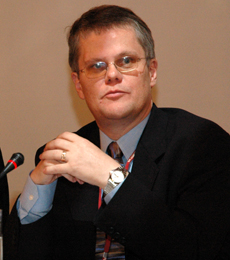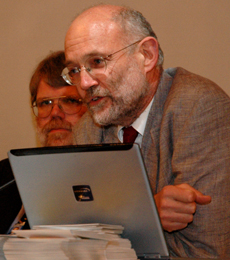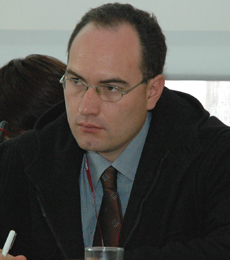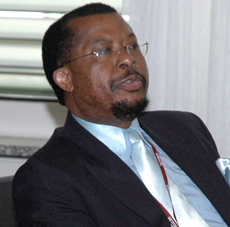 |
||
|
published by IISD, the International Institute for Sustainable Development
in cooperation with the Climate Change Secretariat. |
|||
|
Special Report on Selected Side Events at SB 22
|
|||||
| 19-27 May 2005 | Bonn, Germany | |||||
 |
||||||||||||||||
 |
||||||||||||||||
 |
||||||||||||||||
|
||||||||||||||||
|
Events convened on Friday, 20 May 2005 |
||||||||||||||||
|
||
|
|||
|
|||||||||||||||||||||||||||||||||||
|
|||
|
Preparing for implementation: Initial requirements under the Kyoto Protocol Presented by the UNFCCC |
||||||
 |
Halldor Thorgeirsson, UNFCCC, said the focus of the event would be the parties' obligation to demonstrate progress in initial reporting under the Kyoto Protocol. He indicated that the Article 8 review process involves: review of initial reports; periodic review of national communications; annual review of supplementary information under Article 7.1 and expedited review to reinstate the eligibility for mechanisms.
Clare Breidenich, UNFCCC, highlighted that problems in the base year inventory detected by the Expert Review Team may reduce the assigned amounts. She emphasized that an accepted review year basis for assigned amounts is final and cannot be revised. She underscored that national inventory systems must be maintainable and reproducible. Andrew Howard, UNFCCC, highlighted the importance of national registries for demonstrable progress reporting. He indicated that parties’ fulfillment of the eligibility requirements under the Kyoto mechanisms are based on the initial report and review. He stated that parties are automatically eligible to employ the mechanisms 16 months after the report has been submitted, but that the Enforcement Branch of the Compliance Committee may suspend the employment of the mechanisms and parties must meet the requirements in subsequent years. |
|||||
| Halldor Thorgeirsson, UNFCCC, encouraged parties to prepare nominations for the election of members of the Compliance Committee | ||||||
|
Katia Simeonova, UNFCCC, specified that the Secretariat must be informed of reporting delays, and indicated that six-month delays will be reported to the COP/MOP and the Compliance Committee, and be made public. She indicated that the review reports will contain information such as: potential problems identified by the review team; the timeliness of submissions; and assessments of how to treat identified problems. Discussion: Participants raised concerns regarding: Article 3.3 and 3.4 activities; activities of the Enforcement and Facilitative Branches of the Compliance Committee; training for expert review teams; and the Kyoto Protocol timeline and base year adjustments. |
||||||
|
|||
|
2006 IPCC Guidelines for National Greenhouse Gas Inventories Presented by the Intergovernmental Panel on Climate Change |
||||||||
 |
Jim Penman, Intergovernmental Panel on Climate Change (IPCC), stressed that the IPCC’s greenhouse gas inventory guideline system has evolved and recognizes the work already done by parties. He said the new Guidelines aim to reduce the amount of cross referencing and promote consistency between sectors. He noted the IPCC’s hope that the 2006 Guidelines will be as useful as those of 1996.
Simon Eggleston, IPCC, summarized the innovations in the 2006 Guidelines, including better coverage of: sources; gases; non-energy product uses of fossil fuels; carbon capture and storage; harvested wood products; and wetlands. He indicated the IPCC’s desire to present the new Guidelines at SBSTA 24 in May 2006. |
|||||||
| Jim Penman, IPCC, explained that the IPCC’s inventory Guidelines have evolved in response to lessons learned | ||||||||
|
On real emissions estimates, William Agyemang-Bonsu, IPCC, highlighted changes including: clarification of the “reference approach” and “sectoral approach”; a new “Tier 1” approach for fluoride gases; and the use of a “first order decay model” for landfills. Presenting on the Agriculture, Forests and Other Land Use (“AFOLU”) sectors, N.H. Ravindranath, IPCC, noted changed features such as: a new approach to inventories for land use and livestock systems; the inclusion of wetlands as a land use category; and the introduction of a common methodology for all AFOLU sectors. Jochen Harnisch, IPCC, presented on the merging of the “Industrial Process” and “Solvent and Other Product Use” sectors. He noted that the new sector accommodates more sources and gases, and clarifies and regroups the source categories. Other changes include better differentiation within the chemical and metal industries, and greater coverage of “other product use” emissions. Discussion: Participants discussed methane emissions from wetlands; emissions from agricultural soils and from the substitution of fluorine gases; consistency between the new and old guidelines; the usability of the guidelines; and IPCC guidance on mitigation. |
||||||||
 |
||||||||
| Left to right: From the IPCC: Jochen Harnisch, N.H. Ravindranath, William Agyemang-Bonsu, Taka Hiraishi, Thelma Krug, Simon Eggleston, and Jim Penman. | ||||||||
|
|||
|
Future of the CDM Presented by Japan |
|||||
 |
In introducing the Japanese initiative on the future of the CDM, Hiroshi Yamagata, Japanese Department of Economy, Trade and Industry, expressed hope that it will contribute to sustainable development. Taishi Sugiyama, Central Institute of Electric Power Industry, presented the outcomes of a workshop held in Tokyo in March 2005, noting the focus on methodology development for energy efficiency projects.
Axel Michaelowa, Hamburg Institute of International Economics, proposed future work on baseline methodologies for energy efficiency projects, including addressing “rebound effects”, and considering standard payback periods and efficiency benchmarks in additionality tests. In discussing “common or consolidated” baselines for expediting methodologies for energy efficiency projects, Jayant Sathaye, Lawrence Berkeley National Laboratory, concluded that: the bundling of projects can reduce transaction costs and the consolidation of methodologies may lead to faster project approval. Kenichiro Yamaguchi, Mitsubishi Research Institute, focused on mass transport projects, noting that methodologies may be complex, and project effectiveness may be under-evaluated. Lex de Jonge, Dutch Ministry of Housing, Spatial Planning and the Environment, indicated support for the Japanese initiative, expressed doubt about the timing of consolidating methodologies, and suggested the initiative focus on improving the efficiency of the CDM EB and the CDM post-2012. Marcela Main, Department of International Affairs, Chile, stressed the importance of: adapting consolidated methodologies to local circumstances; policy and programme-based methodologies; and methodology and project development in the transportation sector. Johans Heiseter, World Bank Prototype Carbon Fund, suggested that the Japanese CDM initiative should be flexible, involve project developers, seek interaction with the EB and the Secretariat, and consider the creation of an Advisory Group with EB representation. Juan Carlos Caycedo, Andean Center for Economics in the Environment, emphasized the need to consider project “rebound effects” and questioned whether the Japanese initiative could join forces with project developers, rather than solely deliver general methodologies. |
||||
| Juan Carlos Caycedo, Andean Center for Economics in the Environment, emphasized the importance of addressing the “rebound effect” in CDM project development | |||||
|
|||
|
||
|
Click the above button to go back to our ENB main coverage
|
||
|
|
|
|
|
||
|



